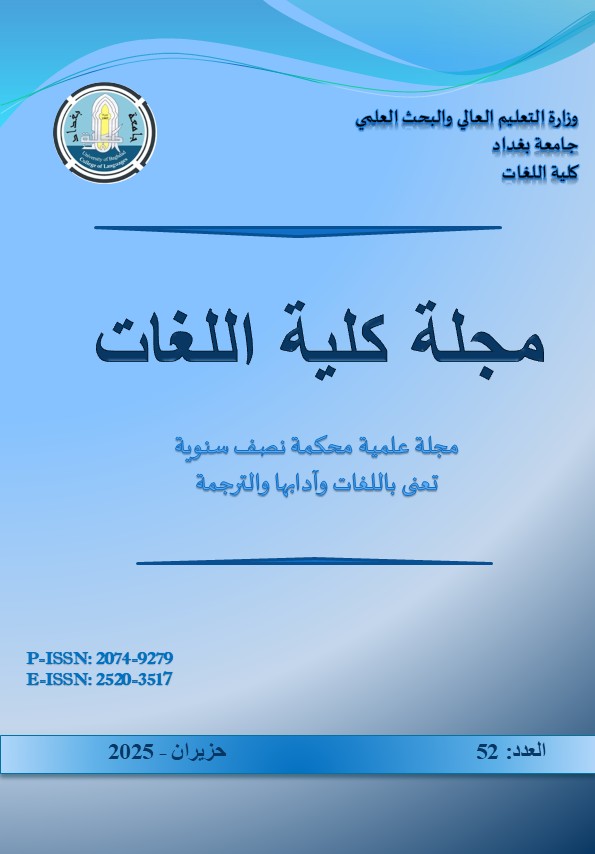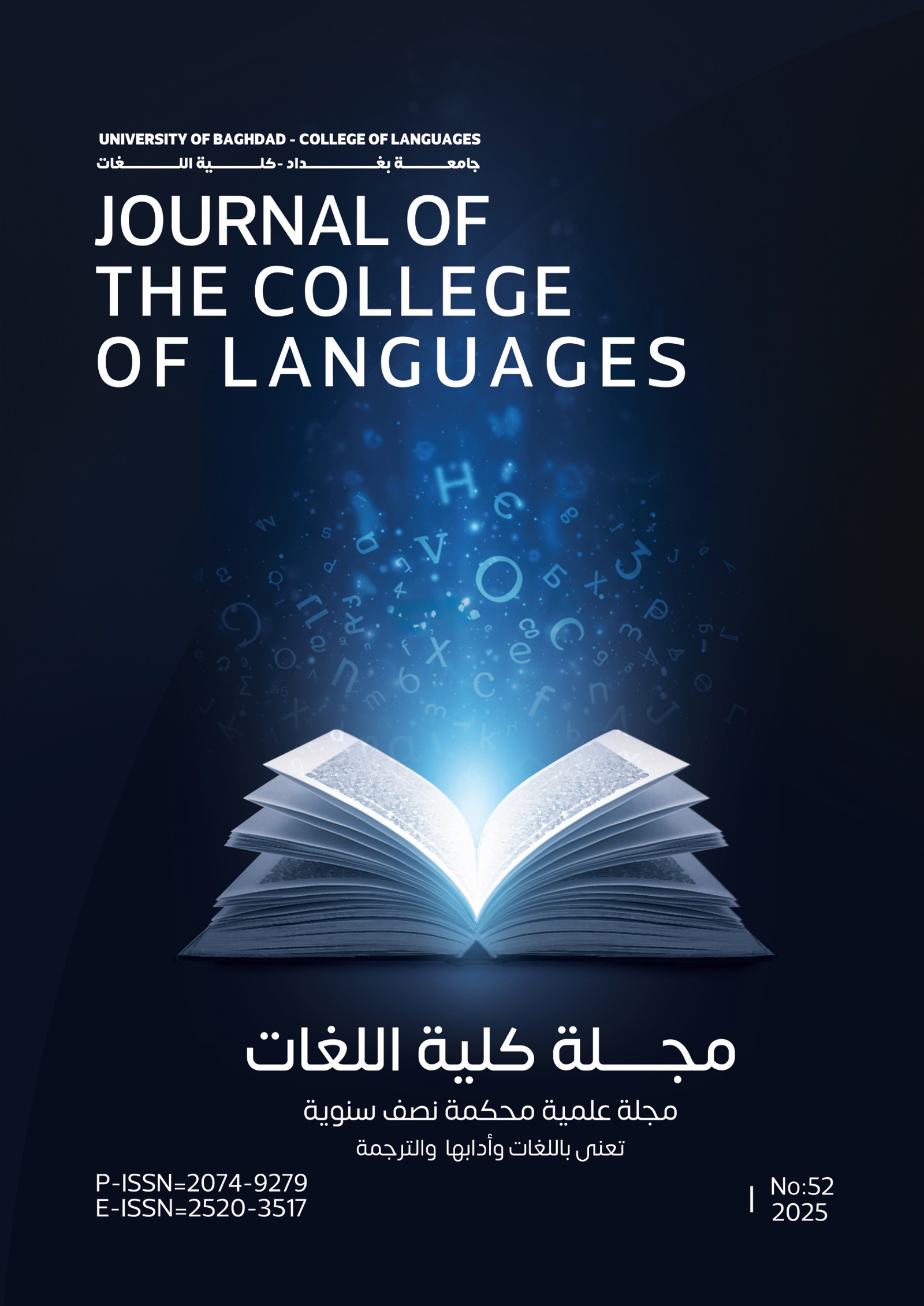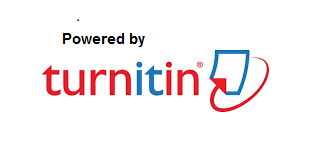تحليل خطاب نقدي للحب و الحزن في قصائد مختارة من شعر الرومي
DOI:
https://doi.org/10.36586/jcl.2.2025.0.52.0085الكلمات المفتاحية:
نظرية فيركلوف لتحليل الخطاب النقدي، اللغة المجازية، الحزن ، الأيدولوجية، شعر الروميالملخص
تناولت هذه الدراسة مفهومي الحب والحزن في إطار السياقين الصوفي، والإسلامي لتحديد كيفية توظيف الأساليب البلاغية لاستكشاف موضوعي الحب والحزن وترابطهما في مختارات من قصائد الشاعر جلال الدين الرومي، كما تهدف الدراسة إلى كشف الدلالات الأيديولوجية المتعلقة بهذين الموضوعين وعلاقتهما في القصائد المختارة، بالتالي تم اعتماد نموذج فيركلوف ثلاثي الأبعاد لتحليل الخطاب النقدي (CDA من الآن فصاعدا) في هذه الدراسة لإجراء تحليل خطاب نقدي لقصيدتين مختارتين من مجموعة جلال الدين الرومي الشعرية المترجمة إلى الإنكليزية بعنوان كتاب الحب: قصائد النشوة والشوق باستخدام ثلاثة مستويات من التحليل هي: النصي، والخطابي، والاجتماعي.و كشفت النتائج أن قصائد الرومي غلب عليها مجموعة متنوعة من الاساليب البلاغية التي تشمل الاستعارة، والتجسيد، والتباين، والمغالاة أو المبالغة، والسؤال البلاغي، والرمز، والتشبيه، والتلميح، والتكرار، و ذلك بهدف تعزيز الترابط الحتمي بين الحب والحزن خلال التجربة الروحانية للفرد في العشق الإلهي الذي لا يزدهر إلا بالتضحية وخوض المصاعب والمحن التي تُنمّي العشاق وتُحفّزهم على النضوج الذاتي في سعيهم نحو الاتحاد الروحي؛ لذلك يُمثّل الرومي الحزن مجازيًا بوصفه عنصرا تحفيزيا وتحويليا مرافق للحب في سبيله الروحاني الذي لا يمكن وصفه بالكلام،و في الوقت عينه يكشف التحليل ثلاثي الأبعاد لهذا الترابط عن مجموعة من الأيديولوجيات و التعاليم الإسلامية و بعض التعاليم العامة مما يستدعي إعادة النظر في الفكرة الغربية الشائعة لتصنيف أعمال الرومي الشعرية كأشعار حب.
المراجع
Abbaspour, B. N., Mahadi, T. S. T., & Zulkali, I. (2021). Ideological manipulation of translation through translator’s comments: A case study of Barks’ translation of Rumi’s poetry. Pertanika J. Soc. Sci. & Hum., 29(3), 1831-1851. doi: https://doi.org/10.47836/pjssh.29.3.19
Adegbenro, E.J. (2025). Style and ideology in Jonathan’s No Enemies to Fight: Goodluck Jonathan on the Marble. Journal of the College of Languages, (51), 1-18. doi: https://doi.org/10.36586/jcl.2.2025.0.51.0001
Al-Doori, M. (2021). The mystical and Sufi experience in selected poems by Rumi and W.B. Yeats (Master’s thesis). Retrieved from http://acikerisim.karabuk.edu.tr:8080/xmlui/bitstream/handle/123456789/1273/10400306.pdf?sequence=1&isAllowed=y
Al-Mas’udi, H. H. B., & Al-A’mery, A. S. A. (2021). Fairclough and Van Dijk models of critical discourse analysis. Adab Al-Kufa Journal, 47(2), 478-490. doi:10.36317/kaj/2021/v1.i48.537
Al-Qudsy, B. W. (2016). A stylistic analysis of figures of speech in the Jakarta post headlines under the issue of KPK vs. Polri (Master’s thesis). Retrieved from https://core.ac.uk/download/pdf/78027133.pdf
Amoussou, F., & Allagbe, A. A. (2018). Principles, theories and approaches to critical discourse analysis. International Journal on Studies in English Language and Literature (IJSELL), 6(1), 11-18. doi: http://dx.doi.org/10.20431/2347-3134.0601002
Ardiansyah, M. F., & Ayu, H. R. S.S. (n.d). Symbolism in Jalal Al-Din Rumi’s the book of love, chapter nine: Absence. Jurnal Mahasiswa Universitas Surabaya. Advance online publication. Retrieved from https://ejournal.unesa.ac.id/index.php/litera-kultura/article/download/9192/9136/12228
Aydin, E. (2004). Whispers of love: Mevlana Jelaleddin Rumi. Retrieved from https://www.dialoguesociety.org/assets/publications/mevlana-jelaladdin-rumi.pdf
Barks, C. (2003). Rumi: The book of love: Poems of ecstasy and longing. USA: Harper Collins Publishers.
Basuki, E.P., & Saputri, T. (2021). Analysis of figurative language of Jalaluddin Rumi’s poems in the Book of Love poems book. Education and Human Development Journal, 6(2), 93-104. doi: 10.33086/ehdj.v6i2
Behtash, E.Z. (2017). Images of ‘love’ and ‘death’ in the poetry of Jaláluddin Rumi and John Donne. International Journal of Applied Linguistics & English Literature, 6(2), 97-105. doi: 10.7575/aiac.ijalel.v.6n.2p.97
Beldi, N., Slimani, S., & Cherchali, O. Z. (2021). Norman Fairclough’s three dimensional approach as an analytical model in the critical discourse analysis of George Orwell’s novel Nineteen-Eighty Four (Master’s thesis). Retrieved from http://dspace.univ-medea.dz/bitstream/123456789/6561/1/MME.62-63.pdf
Burhanudin, H., Sumarlam, & Rakhmawati, A. (2021). The dimensionality on the mayor of Surakarta’s (2016-2021) Javanese covid-19 posters. Humaniora 12(2), 161-171. doi: 10.21512/humaniora.v12i2.7009
Fairclough, N. (1989). Language and power [DX Reader version]. Retrieved from https://www.okehamptoncollege.devon.sch.uk/uploads/6/1/4/4/61443371/ebooksclub.org__language_and_power__language_in_social_life_.pdf
Fairclough, N. (1995). Critical discourse analysis: The critical study of language [DX Reader version]. Retrieved from https://www.felsemiotica.com/descargas/Fairclough-Norman-Critical-Discourse-Analysis.-The-Critical-Study-of-Language.pdf
Fairclough, N. (2012). Critical discourse analysis. In J. P. Gee & M. Handford (Eds.), The Routledge handbook of discourse analysis (pp. 9-20). New York, NY: Routledge. doi: https://doi.org/10.4324/9780203809068
Fan, X. (2019). The research and application of critical discourse analysis. Journal of Language Teaching and Research, 10(5), 1041-1046. doi: http://dx.doi.org/10.17507/jltr.1005.17
Hassan, W., Rehman, A.U., Zafar, A., Akbar, F., & Masood, S. (2019). An application of Fairclough’s three dimensional CDA approach to Fraser Anning’s speech in Australian senate. Linguistic Forum, 1(1), 32-35. doi: http://doi.org/10.53057/linfo/2019.1.1.5
Isma’eel, K. J., & Abdulmajeed, R. K. (2019). The pragmatics of romance in the First World War' poetry. AWEJ for Translation & Literary Studies, 3(4), 61-85. doi: http://dx.doi.org/10.24093/awejtls/vol3no4.6
Jaafar, E. A. (2020). Schema theory and text- worlds: A cognitive stylistic analysis of selected literary texts. Journal of College of Education for Women, 31(2), 52-65. doi: https://doi.org/10.36231/coedw/vol31no2.14
Kadhim, N. A., & Abbas, N. F. (2023). The construction of racism in cartoon films: A critical discourse analysis. Arab World English Journal (AWEJ), 14(2), 221-235. doi: https://dx.doi.org/10.24093/awej/vol14no2.16
Khalil, H. H. (2020). Attitude as a tool for critical stylistics analysis in literary discourse. Asian EFL Journal, 27(5.1), 91-112. Retrieved from https://www.researchgate.net/publication/350580736_Attitude_as_a_Tool_for_Critical_Stylistics_Analysis_in_Literary_Discourse
Kokcu, M. (2020). The divine unity in and beyond nature: A comparative study in Walt Whitman’s and Jalal Ad-din Muhammad Rumi’s ecstatic poems. The Journal of Social Science, 4(8), 633-643. doi: https://doi.org/10.30520/tjsosci.777912
Melly, M. (2022). Figurative language expressions analysis within Ava Max’s selected songs: Semantics approach (Master’s thesis). Retrieved from http://repository.upbatam.ac.id/1509/1/cover%20s.d%20bab%20III.pdf
Van Dijk, T. A. (2013). Ideology and discourse. In M. Freeden, L. T. Sargent, & M. Stears (Eds.), The Oxford handbook of political ideologies (pp. 175-196). Oxford: Oxford University Press. doi: https://doi.org/10.1093/oxfordhb/9780199585977.013.007
Van Dijk, T. A. (2015). Critical discourse analysis. In D. Tannen, H. E. Hamilton, & D. Schiffrin (Eds.), The handbook of discourse analysis (2nd ed.). retrieved from https://discourses.org/wp-content/uploads/2022/07/Teun-A.-van-Dijk-2015-Critical-discourse-Analysis.pdf

التنزيلات
منشور
إصدار
القسم
الرخصة
الحقوق الفكرية (c) 2025 مجلة كلية اللغات

هذا العمل مرخص بموجب Creative Commons Attribution 4.0 International License.







